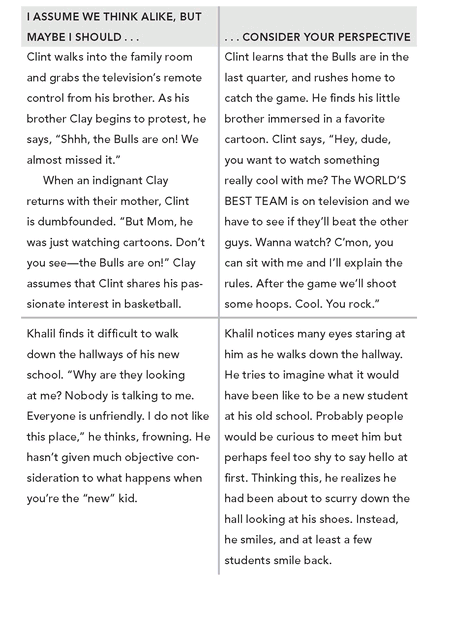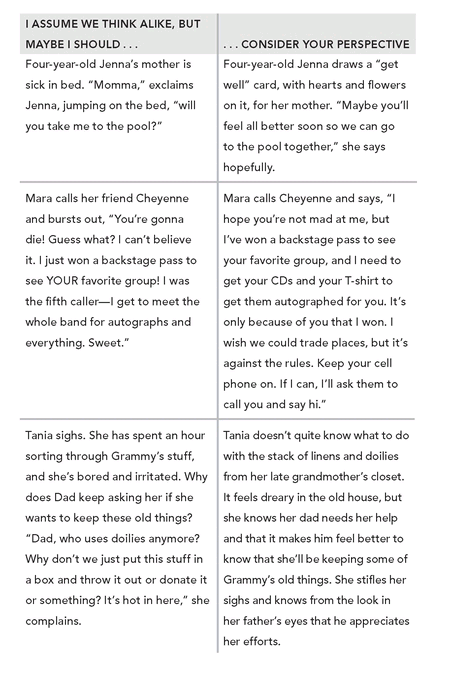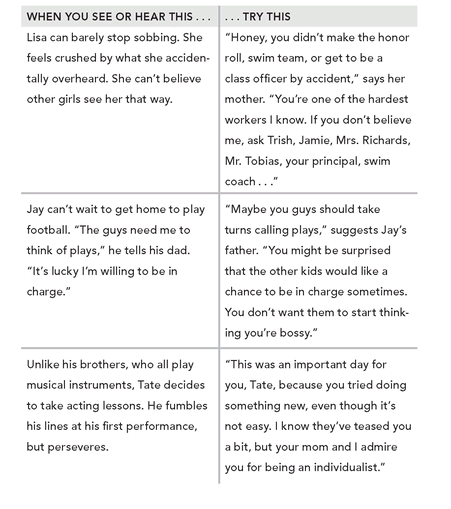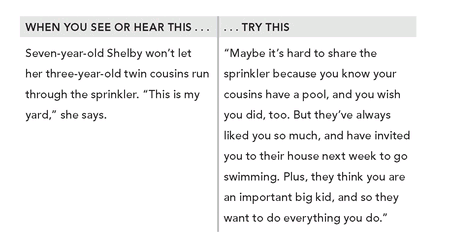CHAPTER 8
Pillar VII
A Mirror for the Mind: The Helping Hand of Self-Awareness
Oneida is only seven, but she’s a forty-eight-pound spark plug whose coach says could develop into a seriously competitive gymnast. She flies through the air without fear and rebounds without hesitation when she falls. “She’s incredibly determined, but sometimes it’s too much,” says her dad. “Oneida forgets that there are other kids in the gym, and she doesn’t like to share her coach’s attention. She knows she’s talented—and that we’re so proud of her. I just wish she could learn to be more aware of how she comes off to others. There are always so many unnecessary conflicts. Is she old enough to get that stuff?”
Jonathan is eleven, but he’s extremely tall for his age and feels awkward about it. His most stressful experiences come during the most “public” times of day at school—walking in the hallway and at gym and recess. At these times, Jonathan is most visible, and he feels intensely self-conscious about towering over the other kids. A few peers have picked up on his embarrassment and have called him names and made “monster” sounds as he walks. Jonathan’s parents have met with his teacher twice, concerned that he has begun to cry spontaneously and refuses to go out in public with them. His teacher isn’t sure what to do. “I know Jonathan is big,” she says, “but there are other big kids in school who are proud of being tall, and act like it. The other students seem to accept them well enough. But Jonathan looks like he’s hunching over and hiding, and that makes him a target because he doesn’t show any confidence. I wish he could see how he looks and maybe learn to see his size as an advantage.”
So far we’ve considered six of Factor Ex’s Eight Pillars. Our focus has been on elements of problem-solving related to getting things done, getting them done efficiently, paying attention, and following through. Now we’ll see more specifically how the executive brain promotes social development and interpersonal problem-solving. Whether we’re talking about brothers learning to get along, classmates negotiating responsibilities for a group project, or a teenager trying to land a good part-time job, the executive brain is enabling insight and shaping decisions to solve the problem. This is because Factor Ex helps a person to monitor himself, including knowing when choices successfully bring about a desired result, or when another approach to a particular situation is needed. These aspects of self-awareness help a child to engage life’s social flow, navigating the twists and turns that are inevitably part of social interaction.
The first stage of self-awareness is simply to question, “Who am I?” and “Am I different from others?” (For example, “I’m a person who likes math more than my friends do.”) The second stage of self-awareness follows the realization that not only am I different from others, but others think differently than I do; people have different preferences and opinions. And this leads to the question “How am I seen by others?” (“Does my teacher like kids like me?”) The third stage of self-awareness builds on this accumulating knowledge and leads to a more complex need: reconciling differences between how a person sees herself and how she is perceived by others, and how this knowledge should change her behavior—if indeed it should. (For example, “Even though it’s hard for me to be patient, if I jump in with all the answers, they’ll think I’m showing off.” Or, “I’m so thirsty I could drink the whole gallon of Gatorade, which seems normal to me for after a game, but if I do, Mom will think I’m overdoing it—and may call me her ‘little beastie.’ I guess I could leave a little for someone else.”)
These stages of self-awareness represent different levels of social capability. They don’t fully develop until late adolescence, or even adulthood. Acquiring self-awareness can be particularly challenging for children with cognitive disabilities. Genji, a bright sixteen-year-old with Asperger’s syndrome, says his parents sometimes get upset when he does something insensitive. “I don’t always think about other people’s feelings when I say things. If I want to say something about how somebody looks or what they’re doing, Dad says to check with him first, because once I told my cousin, ‘You’re very short,’ which was true, but incorrect if you know what I mean.”
Children and adolescents with ADHD often have difficulty with self-awareness, because inattention and impulsivity get in the way of the self-reflection and practice necessary for social learning. During a recent evaluation, I asked Barbara, the mother of nine-year-old Jake, how he does with other kids at school. “That’s really why we’re here,” she said. “We can deal with the hyperactivity, but I’m concerned about the impression he’s making on other kids. I watch Jake on the playground and he’s overpowering. He can’t wait to play with other kids, but it’s beginning to look like a ‘one-way street.’ The other kids seem to shy away from Jake.”
Self-awareness evolves from important dynamics within the brain, particularly the relationship between the prefrontal cortex and the right hemisphere. Neurodevelopmental disorders such as a nonverbal learning disability, Asperger’s syndrome, and other deficits in social relationships stem, in part, from poor coordination between the brain’s prefrontal cortex and right hemisphere. These areas of the brain work in tandem to create effective social thinking skills, especially self-awareness. In 2001, a remarkable study published in Nature described an experiment that required individuals to remember seeing a picture of their own face after their right, and then left, hemisphere was anaesthetized. The subjects in this experiment had no trouble recalling that they had seen a picture of themselves when their left hemisphere was inactive, but had no recollection of their own self-image when the right hemisphere was anaesthetized. This study highlights the pivotal role of the brain’s right hemisphere in helping us to keep track of ourselves. In so doing, Factor Ex helps us to see ourselves a little more objectively and, by extension, offers a viable chance of developing very useful forms of capability.
Words, Face, and Hands
Children with special needs are at increased risk of being cast in a social light that is not a conscious choice. In some cases, because of limited self-awareness, they meander into the role of either victim or bully. Here are some simple, practical ways you can bring a child’s attention to the signals he sends others.
Be Aware of Your Words . . . • Are you talking as much as the others? Doing all the talking? Not talking at all?
• Are you talking about the same topic as the others?
• Are you saying things in a way that doesn’t hurt other people’s feelings?
Be Aware of Your Face . . . • Are you smiling or frowning?
• Are you remembering to make eye contact with others?
• Are you listening with your eyes as well as your ears?
Be Aware of Your Hands . . . • Are you touching someone else or their belongings at the wrong time?
• Are you accidentally making too much noise with your hands or feet?
• Are you scratching, picking at, or rubbing your body?
• Are you pulling or chewing on your hair?
Ask a child to see if he can do what most of the other kids are doing with his words, face, and hands. This will help him to be more attentive to others—a great pathway to social awareness. Kids with substantial challenges need ongoing coaching in these areas to help compensate for a more slowly developing
Factor Ex.
A Mirror for the Mind—The Shining Light of Objectivity
Recall that some of the other pillars we’ve discussed (initiation, planning) help kids formulate goals, including social objectives. The pillar of self-awareness helps a child to consider specific actions, whether they should be modified, and if so, how. Being self-conscious is potentially disabling, causing a child to freeze with anxiety and confusion, or withdraw from situations that require interpersonal problem-solving. In contrast, being self-aware suggests self-control, and the ability to steer one’s behavior to yield positive reactions. The capacity for self-awareness is at the root of making connections between actions and their consequences.
Self-awareness helps build a base of practical knowledge by collaborating with working memory to commit chunks of new information to longer-term memory. Of course, age and experience help kids become more self-aware. For example, an eight-year-old may not yet have collected enough information about how she affects others to understand what she can change to win new friends. (Perhaps she doesn’t see that a pattern of disappearing friends is somehow related to bossiness.) However, through experience, an eleven-year-old may do a much better job of adapting his behavior to fit in with a particular group of peers. (“Maybe I’ll only use my iPod when I’m sitting alone.”)
In puberty and adolescence a heightened degree of self-consciousness is normal as kids grapple with changing bodies, hormones, and evolving sexual interest. During this phase of their life, one of our jobs as mentors is to help kids maintain a degree of perspective in the midst of all these transitions. Openly acknowledging the difficulties—with a “matter-of-fact” tone—can help children transition from the vulnerability of self-consciousness to the confidence inherent in self-awareness.
Looking in Both Directions
Self-awareness is a way to “look both ways before crossing”— avoiding potential problems before they occur. For example, Ethan can recall what happened the last time he forgot to say hello to his cousins, and can plan to fix it next time; he’s beginning to grasp social cause and effect with greater sophistication. Part of what allows a child to develop social proficiency is her capacity to look back at experiences that have had an important effect on her self-concept. Lauren is a very beautiful girl. While she enjoys the attention she attracts, she remembers an instance in the past where she flirted with a boy she didn’t care for, mostly because she was excited by the thrill it gave her to see his strong reaction. But she also remembers feeling terribly guilty when the boy was badly hurt because she didn’t reciprocate his ongoing interest. Yet although she was inconsiderate at fourteen, at eighteen she is more careful about how she relates to others. In her words, “Not to brag, but being considered attractive can mess with your head, because you have a certain power over some people, so you have to know how to act. Some girls I model with just play games and are, like, ‘Watch me rule this guy.’ I have to realize that people might react to me in a certain way, and handle it.” By being able to access past experiences and relate their common denominators, older children and adolescents develop the insight to respond to others constructively.
A Favorite Technique . . .
We can help kids of all ages benefit from what they have already learned by bringing past experience into greater focus through helpful, leading questions. This technique works best in circumstances where you are aware that a child is struggling with an important decision.
“I see, you want Jillian to share her magic wand with you more. Well, what makes you want to share with someone? Did you ever notice which toys of yours Jillian likes? What’s your best way of asking for a toy? Mm-hmm, and if you do that, what will Jillian think about you?”
“Okay, so you want more people to come to your party.
Should you let people know the date earlier than last time? I wonder if a personal invitation might make a difference? What can you think of that you know kids like to do? Should you ask a friend for some ideas before you make up your mind about the day and time?”
Self-Awareness Signals Maturity
Emerging self-awareness is an important indication of evolving maturity. We see mature children as, among other things, those who benefit from past learning experiences, who can demonstrate self-control (goal-directed action), and who know how to fit in with different groups. We may detect these capabilities by listening to a child’s language, or by watching his interaction with others. And of course, our perception of a child’s maturity is relative to that of his or her peers, is contingent upon circumstance, and changes over time.
LISTENING AND WATCHING FOR SELF-AWARENESS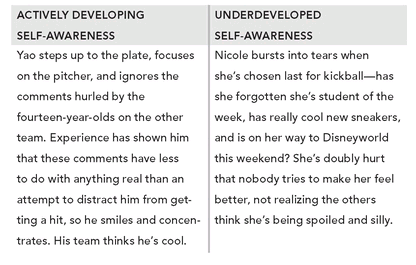
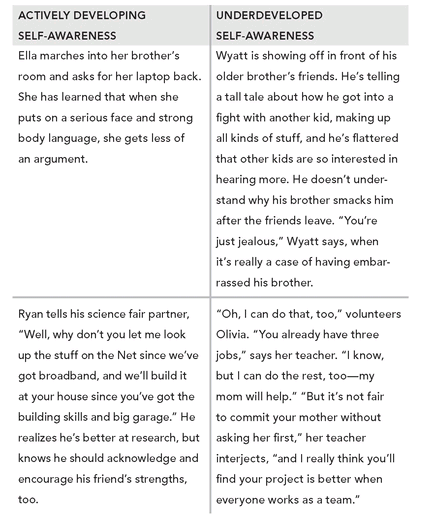
We are all vulnerable to a degree of self-deception. (Sometimes, this is a useful defense mechanism when we’re confronted with a realization so harsh the best we can hope to do at that moment is cope.) However, most of us know adults who suffer and cause misery because they have not developed the skills of self-awareness. We understand and forgive unaware or silly behavior in young children. But society loses its forgiveness at about the same time we become more capable of getting into situations where such behavior can cause serious damage— adolescence and adulthood. A “goofy kid” who acts foolishly at a birthday party is forgiven; an adult who lacks self-awareness at the office holiday bash is considered a jerk and short-listed for layoff. Self-awareness is a major part of Factor Ex, particularly entwined with popularity, friendship, and the ability to lead others. When we meet someone who annoys, offends, or angers us, we often think, “Can’t she hear what she sounds like?” or, “Doesn’t he realize he acts like that?”—perhaps not recognizing the poignancy of our questions. The answer may very well be “no.” The skills of self-awareness take root in childhood, and are profoundly connected with the growth of empathy—the key to harmonious relationships.
Who Am I?
As soon as a baby begins to recognize that she has a separate body from her mother, the first inkling of self-awareness has emerged. Although we try to meet infants’ needs quickly to provide a sense of security, even very young children learn that their desires will not always be met immediately. Sometimes, another situation may be more pressing—“Yes, Tara, Mommy will roll the ball, but first your sister needs help on the potty.” For most kids, this is a difficult yet necessary step toward recognizing personal boundaries and acknowledging that the world is inhabited with people who sometimes have conflicting needs. Still, basic self-awareness helps children learn to navigate these conflicts and to advocate for their own self-interest. (Being self-interested is not something to be concerned about in young kids.
Rather, it is a sign that a child is learning to fend for her- or himself—a fundamental part of growing up. As adults, we can reinforce that good decisions align with self-interest: Deciding to play nice, take turns, and “just say no” all pay huge dividends.)
During the who am I? stage of self-awareness, a child is taking her first steps toward discovering how to belong as well. When we understand who we are, we have a better sense of where we might fit in, and with whom we most want to affiliate. Factor Ex can help a child to analyze what traits he has in common with another, and also help him to see that common traits are a bridge to social connection. Of note is that children who are kinesthetically oriented, who learn by running, touching, and doing, are sometimes delayed in understanding themselves as beings beyond their physical bodies. The kids who crash into you to say hello, or live to run or surf, may have difficulty describing feelings, understanding motivations, or considering how their actions impact others. Combine this with a propensity for frequent and intense physical sensation, and you have a child who likely needs a lot of good coaching to stay out of trouble and form healthy relationships.
Is Your Child a Busy Bee?
Very active, kinesthetic kids often lag behind peers in developing self-awareness and related social skills. When a child is born with a body that is athletic, well coordinated, and highly energetic, that is where he’ll want to focus his learning. He may learn to “pop a wheelie” before he can give a compliment, or run a four-minute mile before he can figure out how to carry on a sociable conversation. In part, this is the natural order of human beings. Almost none of us are gifted in every capacity. (I still can’t pop a wheelie!)
Who Are You?
Not only are children learning to recognize who they are, they’re also learning about fundamental differences between themselves and others. Gaining knowledge of these differences is a big step toward learning how to negotiate interpersonal relationships. For a very young child, that might mean resolving a dispute about what game to play, while for a teenager, it may mean being able to resolve values differences with a close friend. In all forms, negotiating interpersonal differences is a skill that helps us to live in harmony with other people. Here are several examples of self-other awareness in action, as it might appear within various age groups:
MAKING SENSE OF INTERPERSONAL DIFFERENCES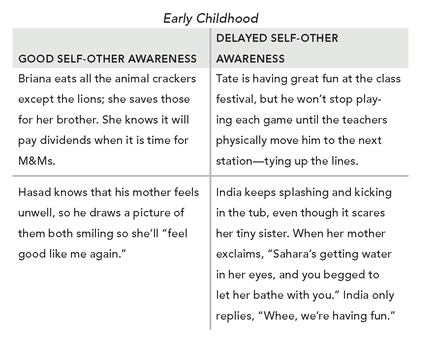
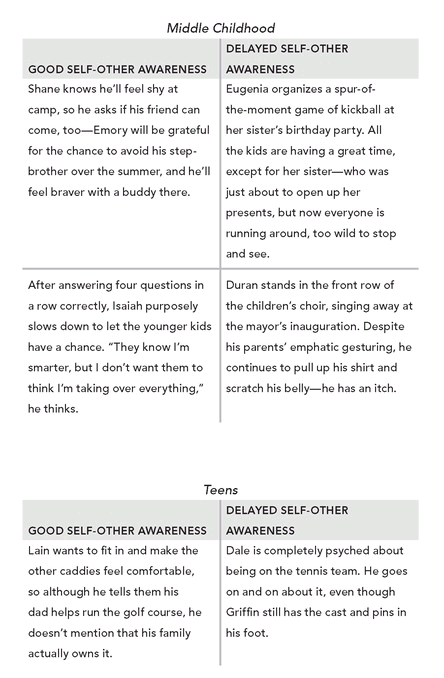
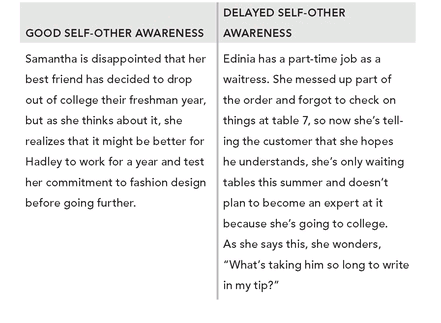
A complicating factor in learning to appreciate interpersonal differences may be that we’re wired (predisposed) to see others as being like us rather than different. Experimentation by Dr. Vittorio Gallese and many others is revealing the powerful effect of what are called “mirror” neurons. These special brain cells are activated whether an individual performs a task, or that individual watches someone else perform the same task. For example, the brain cells we activate when helping Mom unload the groceries are the same cells activated when we watch our younger brother help Mom with the same task. Researchers have learned that when our mirror neurons are activated, we assume that the other person’s intention for doing a particular task is the same as what ours might be in the same situation. So when our younger brother helps out, we might assume, “He’s just trying to get on Mom’s good side” (our intention) rather than being altruistic (perhaps his actual intention). Still, this incredibly exciting aspect of neuroscience is helping to shed light on the biological basis of empathy by illuminating how the brain appreciates the feelings of others. From a teaching perspective, mirror neurons are also a powerful tool, helping to explain the value of practicing what we preach. As kids watch our consideration of others in practice, they are building their own neural networks of empathy and consideration.
Theory of Mind
An important benchmark for interpersonal awareness is the emergence of what psychologists and researchers call theory of mind. This crucial aspect of thinking and reasoning pertains to having an awareness that others may have thoughts or feelings that are their own, uniquely different from ourselves.
Very young children have not yet developed a theory of mind and, as a consequence, often believe that others hold the same thoughts that they do. In a classic theory of mind experiment, three-year-old children are given a box with pictures of candy on the outside, and asked, “What’s inside the box?” Most three-year-olds answer, “Candy,” only to be surprised to find that when they open the box, there are only yellow pencils inside. Next, the box is closed and the researcher asks, “What will your friend think when he looks inside the box?” The confident three-year-old replies, “Pencils.” Hmmm . . . why do three-year-olds think that another child will believe there are pencils in the box? Because they assume that what is in their minds—what they have learned—is shared by others, as if we all shared one giant collective mind. This is a sign that some aspects of self-other awareness have not yet developed. In contrast, a four-year-old, asked the same question, recognizes that there is an element of deception involved in the experiment. More specifically, when a four-year-old is asked, “What will your friend think is inside the box?,” she will say, “Candy,” recognizing that another child will be deceived by the illustration of candy on the outside of box just as she was.
This experiment illustrates how early in life children begin to appreciate that different people in the world are looking through their own lens of personal experience. This contributes significantly to the development of empathy. As children learn that others have their own unique and legitimate perspectives, they can begin to appreciate that not everybody will see things exactly as they do. I’m afraid it’s true: Great minds don’t always think alike. Over time, most people learn to make educated guesses about how others might be feeling or thinking, and take those feelings into consideration during actions or responses, leading to—voilà—empathy.
While most four-year-olds may be able to predict the thoughts of a peer, children with autism spectrum disorders typically take much longer to develop the same understanding. In fact, an absence of theory of mind skills is currently thought to be the most significant social deficit among people with autism. However, help may be on the way: Researchers at MIT have recently invented what they call “The Emotional-Social Intelligence Prosthetic.” This is a wearable computer that assists with interpreting the thoughts and emotions of others by detecting their head and facial movements. The computer then communicates these interpretations to the wearer via sound and tactile feedback. Hmm . . . could this be an end to awkward social moments? Unfortunately, probably not. Can you think of any very personal situations where wearing a computer might change the mood? In the interest of remaining more practical, the following are some basic strategies for building and reinforcing a foundation of self-awareness.
Learning About What Others Are Thinking • Comment on different choices. “It’s amazing how you’d spend every minute playing video games, but your brother is practically glued to the tractor.” “You know what I like about you? You’re the youngest member of our family but the bravest when it comes to trying new things.”
• Encourage healthy mind-reading. “Hey, they’re bringing in a new quarterback with a minute to go. What do you think is going through this kid’s mind?” “Did you ever notice Emery always walks home alone? Is that by choice or is he feeling shy?”
• Anticipate the feelings of others. “You’re certainly entitled to be angry, but I wonder if you’re missing the point about why she wore your sweater. Ever notice how much your sister wants to be like you?” “I can think of two possibilities. One possibility is that he’ll be surprised to see you—any ideas about what the other is?”
• Frequently ask why. “I’m proud you can guess what Uncle Frank thinks about his neighbors, but why do you think he has those thoughts?” “Look at your baby sister trying to talk to you. Why do you think she tries so hard even though she knows only a few words?”
How Others See Me
By developing an understanding of ourselves as individuals, we can better consider the perspectives of other people, including how other people see us. This evolving ability comes with some substantial benefits. When we understand how others perceive us, we’re better able to make sense of their actions toward us. By extension, if we want them to behave differently toward us, we’ll have a better chance of adjusting our own behavior to get the response we want. Consider eleven-year-old Esta, who is increasingly annoyed that her grandmother spends relatively little time talking with her compared with her brother. Her mother notices that Esta is grumping around the house. Esta confides the reason for her bad mood, and in turn, Esta’s mother helps her to understand her grandmother’s behavior. “You know, Esta, ever since you’ve been little, you never liked Grandma’s crafts or garden. I think that hurt her feelings a little. I know she loves you very much, but I’m not sure she knows you love her. Let’s think of a way to show her, and see if you two don’t end up spending more time together.” Activating a child’s executive brain in this way—building insight and judgment— provides stronger feelings of self-control and confidence. After all, self-control is not only about demonstrating socially acceptable behavior, but also about the feeling of being able to achieve a desired outcome.
As children learn to see themselves through the lens of others, Factor Ex is busy crunching this information, making sense of it, logging it in working memory, and hopefully, eventually shifting it into long-term memory. This is the process that leads to accumulated self-knowledge—a critical capability in our increasingly complex, social world.
LEARNING TO CONSIDER THE PERCEPTIONS OF OTHERS
Are we just talking about good manners when we talk about being responsive to others? No—although “good manners” usually reflect personal qualities that draw others to us. When children and adolescents have good social perception, others react positively to the insight, awareness, and empathy that they bring to interpersonal exchanges. Finally, being able to consider multiple views of oneself leads to a broader, more balanced understanding of oneself. For example, a teenager who picks up on someone’s unfavorable assessment—“My English teacher thinks I’m superficial”—can balance that view with an opposing perspective: “But the other teachers like my sense of humor.”
Some children are particularly prone to being influenced by the views of others, causing anxiety or an undue degree of self-consciousness. One sign of maturity is being able to put the ideas of other people into an appropriate framework, so that an awareness of a single perspective is not mistaken for absolute reality when it is only one point of view. This is the concept of subjectivity. Ironically, the notion of being subjective is best understood by a mind that has developed the capacity for objective consideration. In school, children are taught to apply critical thinking to academic topics beginning in elementary school. I believe there’s an argument for extending this educational track to the analysis of interpersonal information; in many cases it would help raise self-esteem and increase emotional intelligence in more meaningful ways than the generalized “I am special” programming meant to be uplifting.
Applying a Multilayered Lens
The next plateau in self-awareness is achieved when a child is able to combine multiple perspectives of him- or herself—and understand how those views shape the way he behaves. Clearly, this is a more complex type of self-awareness that involves looking at oneself through a lens that has several layers of information. You may recognize how our discussion of working memory is relevant. Simply put, considering multiple perspectives requires that sufficient information be held in working memory long enough to be thoughtfully considered. For example, Tucker considers withdrawing his name from contention based on the comments of Bryce, but a few moments’ more thought reminds him that three other kids said they think he’d make a great crossing guard. Grasping the rhyme and reason for their behavior—understanding that their actions are not arbitrary—is particularly empowering for older children and adolescents.
When I meet with children in my office who are unable to articulate basic preferences, likes or dislikes, or who simply can’t respond to basic types of self-awareness questions (What makes you a good friend? How are you different from your sister?), I’m concerned that limited self-awareness is obstructing their social development. In a sense, these children have a jumbled self-narrative—one life experience is not easily connected with another. It’s as if you have no understanding that the reason you love horses is because your mother had been a competitive rider, and the reason you became a veterinarian is because you spent half the waking hours of your childhood in a stable. The examples below illustrate how you can reframe your own child’s experiences to help her develop more sophisticated self-awareness.
ENCOURAGING A MULTILAYERED SELF-PERSPECTIVE
Everywhere we look, whether it’s in the workplace, in families, or at school, we see the need for people who have the capacity to embrace a multidimensional perspective of themselves without resorting to dichotomous, “black-and-white” thinking. Our world, and especially relationships, are comprised of many more colors. Please teach children from an early age to detect and appreciate these differences. On behalf of their prefrontal cortex, I thank you.
We’ve seen how self-awareness contributes to a better understanding of oneself, and one’s differences with others. Gaining the capacity for greater objectivity is the fulcrum on which this important perceptual skill tilts. But what factors affect how easily objectivity is attained? In the next chapter, we’ll see how emotions that aren’t held in check complicate self-perception and, ultimately, how one is perceived by others. We will see that the lifelong dance between reason and emotion—a ballet of mental and emotional well-being—is choreographed by the remarkable executive brain.






